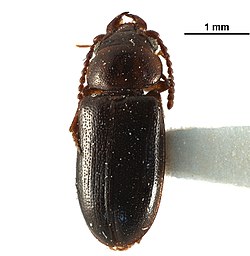| Boganiidae Temporal range: | |
|---|---|
 | |
| Specimen of Paracucujus | |
| Scientific classification | |
| Domain: | Eukaryota |
| Kingdom: | Animalia |
| Phylum: | Arthropoda |
| Class: | Insecta |
| Order: | Coleoptera |
| Suborder: | Polyphaga |
| Infraorder: | Cucujiformia |
| Superfamily: | Cucujoidea |
| Family: | Boganiidae Sen Gupta & Crowson, 1966 |
| Subfamilies | |
See text | |
Boganiidae is a family of beetles, in the superfamily Cucujoidea. Members of the family are found in southern Africa, Australia and New Caledonia. Adults and larvae are pollenivorous, feeding on the pollen of cycads and flowering plants of the families Myrtaceae, Meliaceae, Cunoniaceae and Elaeocarpaceae. [1] Metacucujus and Paracucujus act as pollinators for cycads Encephalartos and Macrozamia respectively. This association with cycads goes back to at least the Mid-Cretaceous, with an extinct form being found with preserved cycad pollen in 99 million year old Burmese amber. [2]